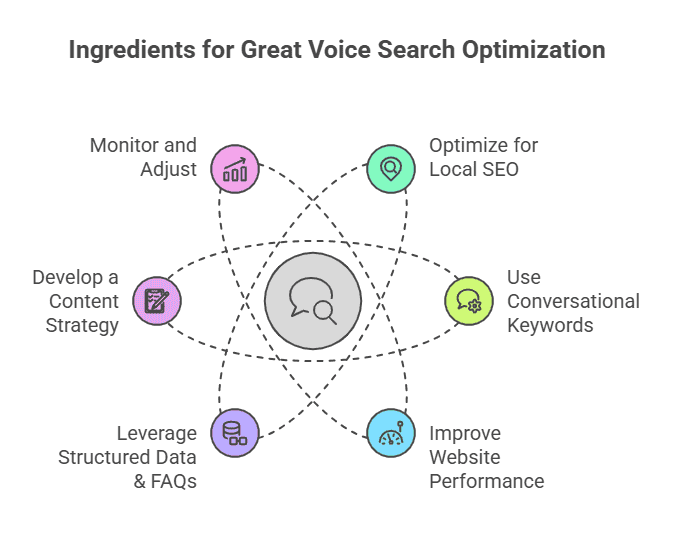What is Voice Search Optimization and Why is It Crucial for Your Business?
Is your website optimized for voice search?
Jump Ahead to Learn:
To busy to read? Listen the podcast summary. 4 minutes
Introduction to voice search optimization
Over 50% of Canadians now use voice commands on their smartphones or smart speakers to get information fast. Voice search is reshaping the way consumers find local businesses every day. In this article, I’ll explain what voice search optimization (VSO) is. Why it matters to small business owners in Ontario and the rest of Canada, and provide practical steps you can take to integrate this digital marketing strategy into your larger SEO and Content Strategy to improve your website and get ahead.
Understanding Voice Search Optimization
What Is Voice Search Optimization?
Voice Search Optimization (VSO) or Voice Search Optimisation (for my Canadian friends) is all about making sure your online content is easily found and understood by voice assistants like Siri, Alexa, and Google Assistant. These devices now use powerful language models (LLMS) like ChatGPT, DeepSeek, Claude, and Qwen to interpret and answer questions.
In simple words, VSO means tailoring your website so that when someone asks a question out loud, your business is the one that pops up as the answer. If you have the answer, they are more likely to visit your website for more information.
How Does Voice Search Work?
When you speak into your phone or smart speaker, your question goes through a process called natural language processing (NLP). This technology helps the device understand your query’s meaning and not just the exact words.
For years, traditional SEO was about placing specific keywords into your content. But voice searches tend to be longer and more conversational. For example, someone might type “pizza Toronto,” but when they speak, they might ask, “Hey Google, where can I get the best pizza in Toronto?” This difference is key to understanding why VSO is so important.
A Quick Look at Traditional SEO
Before voice search, SEO was text-based searches. It made sense to focus on placing keywords in your content. No matter how well it was integrated.
Business owners would target short or long, specific terms to rank high on search engines. With voice search, however, the conversation shifts to longer, natural-sounding phrases that match how people speak. This means we must also change the way we create content.
The Growing Importance of Voice Search
Market Trends You Should Know
Recent studies show that voice search is growing fast. Globally, about one-fifth of people use voice search, and in Canada, over 55% of voice search users have a smart speaker or use voice commands on their mobile devices. In Ontario, this means more local customers are asking for services or directions out loud, making your online presence crucial.
According to Statistica, in the US, people using voice search with voice assistants is growing at about 2.5% to 3% a year.
How Consumers Use Voice Search
Voice searches are often about finding local information quickly, like store hours, directions, or a nearby service. With about 58% of voice users searching for local business information, it’s clear that having an optimized voice strategy can put your business in front of the right customers at the right time.
Benefits for Your Business
When your content is voice-search friendly, you can enjoy:
Enhanced Visibility: Your business appears as the answer when someone asks for local recommendations.
Faster Information Retrieval: Customers get quick answers, improving their experience.
Increased Local Traffic: More customers find you when they use local voice searches.
Why Small Businesses Must Embrace Voice Search Optimization
For small business owners, especially in a competitive market like Ontario, embracing VSO can give you a serious edge.
Enhanced Visibility and Competitive Edge
Getting your business to embrace voice search technology and to show up in voice searches can boost your local visibility. Early adoption of VSO means you can stay ahead of competitors who are still using traditional SEO strategies.
Cost-Effective Marketing
Voice search is a low-cost method to reach potential customers. Instead of spending a lot on ads, you optimize your existing content to match how people talk, saving money and time.
Improved User Experience
When your content is optimized for voice search, it’s easier for customers to get the information they need. A smooth, friendly user experience leads to happier customers and more loyal business.
Actionable Steps for Implementing Voice Search Optimization
Ready to get started? Here are some practical steps you can take right now.
Optimize for Local SEO
Claim Your Google My Business Listing: Make sure your business details are accurate and up to date.
Keep Your NAP Consistent: Ensure your Name, Address, and Phone number are the same across all directories.
Use Conversational Keywords
Instead of just targeting “best salon Toronto,” think like your customers. Use phrases such as “Where is the best hair salon in Toronto?” Tools like AnswerThePublic and Google’s People Also Ask section can help you find these natural phrases.
Improve Website Performance
Boost Site Speed: Use tools like Google PageSpeed Insights or GTMetrix to optimize your website and make it load faster.
Ensure Mobile-Friendliness: Most voice searches happen on mobile devices, so your site should be mobile friendly and work well on any screen.
Leverage Structured Data & FAQs
Implement Schema Markup: Use structured data to help search engines understand your content better. This is especially useful for FAQs.
Create FAQ Pages: Address common questions in a clear, conversational manner.
Develop a Content Strategy
Answer User Queries Directly: Write content that answers the specific questions your customers might ask.
Keep it Conversational: Use a friendly, approachable tone so that the content sounds natural when read aloud.
Monitor and Adjust
Regularly check your website’s analytics to see how your voice search strategy is performing. Tweak your content and keywords based on what you learn.
Voice Search Case Studies & Success Stories
Local Restaurant Boosting Bookings
A neighborhood restaurant optimized its website with conversational, location-based keywords. After updating their Google Business info, they saw a 20% increase in online reservations within two months. This shows that when you speak the language of your customers, they are more likely to choose you.
Bakery’s Rise in Traffic
A small bakery added Q&A content and structured data to address queries like “Where can I buy gluten-free cupcakes near me?” They experienced a 200% boost in local search traffic and a 35% increase in foot traffic within three months.
Financial SaaS Content Engagement
A financial startup restructured a guide to answer common voice queries about cash flow forecasting. The result? A 40% increase in user engagement as customers found the clear, spoken-friendly answers they needed.
AI Voice Search Optimization: How LLMs Enhance Voice Search
Advances in AI, especially large language models (LLMs) like ChatGPT, have boosted the power of voice search. Here’s how:
Natural Language Understanding
LLMs help voice assistants understand conversational queries much better. They can pick up on the context and meaning behind your questions, so if someone asks, “Do I need an umbrella today?” the assistant knows you’re asking about weather, not just the word “umbrella.” You can read more about how Google’s BERT improves search results.
Contextual Accuracy
These models handle context and ambiguity by processing multi-sentence questions. This means your content needs to be clear and well-structured so that voice assistants can pick out the most important points. The new Google Assistant with Bard is a great example of this technology in action.
Best Practices for Voice Search and LLM Integration in Ontario
If you’re a small business owner in Ontario, here are some tailored tips:
Use Conversational, Long-Tail Keywords
Focus on natural, question-based keywords that match how people speak. Instead of “best pizza,” try “Where can I find the best pizza in Ottawa?”
Optimize Your Local Presence
Ensure your business info is accurate on all platforms, especially your Google Business Profile.
Create Q&A and FAQ Content
Structured Q&A content is more likely to be featured in voice search results. Write clear, concise answers that a voice assistant can read aloud easily.
Leverage LLM-Enhanced Tools
Use tools that integrate LLMs to analyze customer queries and suggest improvements to your content. These tools help you keep your content updated with the latest search trends.
Frequently Asked Questions (FAQs)
-
Many VSO steps, like updating your website content and claiming your Google Business Profile, are low-cost or free. Advanced tactics like structured data might require technical help, but overall, VSO is very budget-friendly. It does take time to implement.
-
You may see changes in local traffic and engagement within a few months. Consistent updates and monitoring are key.
-
While exact results vary, businesses that optimize for voice search often experience better local visibility and customer engagement, leading to more inquiries and sales.
-
Voice search uses natural, conversational language while text search often relies on shorter, keyword-based queries. This means voice search results are tailored to answer full questions in a more human-friendly way.
-
Voice search often has a local intent, meaning people ask for nearby services or businesses. This makes it crucial for local businesses to optimize their online presence, ensuring they appear in local voice search results.
-
LLMs, like ChatGPT and Bard, enhance voice search by better understanding natural language and context. This results in more accurate answers to complex or conversational queries, which benefits businesses that optimize their content accordingly.
-
Not necessarily. Instead, you can update your existing content by including natural, conversational language and long-tail keywords. This approach ensures your content is ready for both text and voice search.
-
Since many voice searches occur on mobile devices, a fast and mobile friendly website is essential. Optimizing your site for mobile ensures that customers have a smooth experience, which can improve your ranking in voice search results.
-
You can use tools like Google Analytics and Google Search Console to monitor metrics such as local traffic, click-through rates, and the specific keywords triggering voice search. This data helps you adjust your strategy over time.
-
Voice search optimization is an ongoing process. As technology and consumer behavior evolve, regularly reviewing and updating your content will help ensure that your business stays visible in voice search results.
Conclusion
Voice search optimization is not just a buzzword. It’s a practical, cost-effective way to boost your business’s online presence. By understanding how voice search works and implementing these actionable steps, you can make sure your business stands out when Ontario customers ask for recommendations. Remember, the future of search is conversational, and by optimizing your content now, you’re setting yourself up for success.
Take Action Today:
Evaluate your current SEO strategy and start making small changes. Claim your Google Business Profile, tweak your keywords, and experiment with Q&A content.





